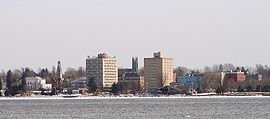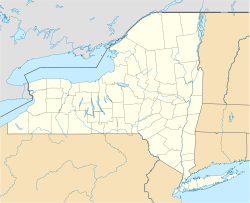- Ogdensburg, New York
-
Ogdensburg, New York — City — Location within the state of New York Coordinates: 44°42′N 75°29′W / 44.7°N 75.483°WCoordinates: 44°42′N 75°29′W / 44.7°N 75.483°W Country United States State New York County St. Lawrence Government – Type Council-Manager – Mayor William D. Nelson (R) – City Manager Arthur J. Sciorra – City Council Members' ListArea – Total 8.2 sq mi (21.1 km2) – Land 5.1 sq mi (13.1 km2) – Water 3.1 sq mi (8.0 km2) Elevation 295 ft (90 m) Population (2010) – Total 11,128 Time zone Eastern (EST) (UTC-5) – Summer (DST) EDT (UTC-4) Zip Code 13669 FIPS code 36-54485 GNIS feature ID 0976759 Website http://www.ogdensburg.org/ Ogdensburg is a city in St. Lawrence County, New York, United States. The population was 11,128 at the 2010 census. In the late 18th century, European-American settlers named the community after American land owner and developer Samuel Ogden.
The City of Ogdensburg is at the northern border of New York, on the south bank of the St. Lawrence River. It is the only city located in Saint Lawrence County.
The Port of Ogdensburg is the only U.S. port on the St. Lawrence Seaway. Ogdensburg International Airport is located south of the city. The Ogdensburg–Prescott International Bridge, northeast of the city, links the United States and Canada.
Contents
History
This was ancient territory of indigenous peoples of varying cultures. By 1000 CE, Iroquoian-speaking peoples were settling along the St. Lawrence River and practicing agriculture, as well as hunting and fishing. Since the 1950s, historians, linguists, and archeologists have found evidence of a distinct people, the St. Lawrence Iroquoians, who inhabited the areas along the St. Lawrence River from before 1300 until the late 16th century.[1] They spoke Laurentian and were a group distinct from the later historical five and Six Nations of the Iroquois Haudenosaunee. By the late 16th century, this people disappeared from the St. Lawrence Valley, probably due to warfare by the Mohawk over the fur trade.[2]
By the time of later French contact, for instance in the early 17th century with Samuel de Champlain, the Five Nations of the Haudenosaunee: Mohawk, Onondaga, Oneida, Cayuga, and Seneca, were allied in the Iroquois Confederacy, based in present-day New York. Onondaga settlements extended up along the south shore of Lake Ontario. Both the Huron and Mohawk used the St. Lawrence Valley for hunting grounds and as a path for war parties.
The earliest European settlement in the area was a French mission, built by Abbé Picquet in 1749. Built near the mouth of the Fleuve Oswegache (French spelling), he named it Fort de La Présentation (Fort of the Presentation). The mission attracted natives for the fur trade, many of whom settled in the village and converted to Catholicism. Mostly Onondaga, the converted Iroquois at the mission became known as Oswegatchie.
By 1755, there were 3,000 Iroquois living at the mission settlement. By comparison, Montreal had only 4,000 residents at the time. Oswegatchie was one of the Seven Nations of Canada. The residents were hostile to the encroachments of British colonists on their territory. During the 1750s and the Seven Years War, warriors from this fort were allied with French officers in attacking British colonists in the Champlain, Mohawk and Ohio valleys.[3]
The city is near the site of the 1760 Battle of the Thousand Islands between British and French forces during the Seven Years War (also known in the US as the French and Indian War.) After the British victory, France ceded its land in Canada to England. The English renamed the installation Fort Oswegatchie, after the native name for the river (as it sounded in French). As with the other mission settlements, the British did not disturb the relationship of the Oswegatchie and their Catholic priests. This became part of Lower Canada or Quebec province. The village remained under British rule until 1796 following the American Revolutionary War. With the northern border redefined by Jay's Treaty, the settlement became part of United States territory.[4]
The first settlers under a United States flag arrived that year. United States settlers essentially drove the Oswegatchie, former British allies, out of the area; many went to Akwesasne or other Mohawk reserves in Canada.
New American residents named the village Ogdensburgh after Samuel Ogden, an early landowner. The community developed around this early settlement and was designated the county seat from 1802 to 1828. During the War of 1812, the city was captured by British forces (see: Battle of Ogdensburg) to end the partial blockade on the St. Lawrence River and harassment conducted from the community. Local merchants used the absence of United States troops to conduct extensive trade with Canada.
The community was incorporated as a village in 1817. Unlike Plattsburgh, it removed the "h" in the spelling of its name. The locale became the City of Ogdensburg in 1868.
Ogdensburg was an important trading city and station in the development of railroads in northern New York and southeastern Canada; the Ogdensburg and Lake Champlain Railroad (1849), Rome, Watertown and Ogdensburg Railroad (1853) and Portland and Ogdensburg Railway (never completed), all involved lines through the area.
In 1940 the town was the site of the signing of the Ogdensburg Agreement between Canadian Prime Minister Mackenzie King and United States President Franklin D. Roosevelt. This renewed the ties between the two countries after the 1939 outbreak of World War II in Europe. The celebrated German POW Franz von Werra escaped from Canada to Ogdensburg in a rowboat.
Demographics
As of the census[5] of 2000, there were 12,364 people, 4,181 households, and 2,583 families residing in the city. The population density was 2,440.0 people per square mile (941.6/km²). There were 4,531 housing units at an average density of 894.2 per square mile (345.1/km²). The racial makeup of the city was 85.05% White, 9.92% African American, 0.80% Native American, 0.69% Asian, 0.06% Pacific Islander, 2.81% from other races, and 0.67% from two or more races. Hispanic or Latino of any race were 6.22% of the population.
There were 4,181 households out of which 31.1% had children under the age of 18 living with them, 41.5% were married couples living together, 15.1% had a female householder with no husband present, and 38.2% were non-families. 32.3% of all households were made up of individuals and 14.2% had someone living alone who was 65 years of age or older. The average household size was 2.39 and the average family size was 2.98.
In the city the population was spread out with 21.3% under the age of 18, 9.5% from 18 to 24, 35.3% from 25 to 44, 21.3% from 45 to 64, and 12.4% who were 65 years of age or older. The median age was 36 years. For every 100 females there were 127.6 males. For every 100 females age 18 and over, there were 134.6 males.
The median income for a household in the city was $27,954, and the median income for a family was $36,236. Males had a median income of $32,358 versus $21,485 for females. The per capita income for the city was $12,650. About 14.2% of families and 18.3% of the population were below the poverty line, including 23.3% of those under age 18 and 13.6% of those age 65 or over.
Education
Ogdensburg is home to the Ogdensburg Free Academy Blue Devils.
Resources
Ogdensburg is home to the St. Lawrence Psychiatric Center, a mental health service provider offering both inpatient and outpatient services. The SLPC is part of the New York State Office of Mental Health (OMH) and serves the general public.[6]
Two private educational institutions, now closed, were formerly located in Ogdensburg. After Mater Dei College closed, its campus was occupied from 2001 to 2009 by Academy at Ivy Ridge. The privately operated boarding school enrolled teenagers with behavioral issues.
The city is the site of the Frederic Remington Art Museum. The downtown museum is housed in the former family mansion of local industrialist David Parish on Washington Street. While the house was always called the Parish Mansion, Eva Remington lived there as a widow after the death of her husband Frederic Remington. He was notable for his paintings of the American West. The collection of Remington art and memorabilia is based on items from the estates of Eva Remington and her sister Emma.
The Fort La Presentation Association has been organized to reconstruct and operate the mission fort as a living history museum. They intend to use it as a basis for education and heritage tourism, as well as an appreciation for the diverse history and peoples of the area.
Ogdensburg is the site of two correctional facilities: Riverview and Ogdensburg. Run by the New York State Department of Correctional Services, the facilities provide jobs for local residents. One is located on the grounds of the former St. Lawrence Psychiatric Center. The other was built directly across state highway 37.
Events
- The Ogdensburg Boys & Girls Club Expo is held on the 3rd weekend in March, and is one of the main fundraisers for that organization.
- The last full week in July is the occasion of the annual Ogdensburg International Seaway Festival. Among the events of the week are the Remington Canoe Race, a local Battle of the High School Bands competition, craft shows, a classic car show, and many other events. The festival ends with a fireworks show on Friday night and a parade on Saturday morning.
Radio
References
- ^ James F. Pendergast. (1998). "The Confusing Identities Attributed to Stadacona and Hochelaga", Journal of Canadian Studies, Volume 32, p. 149, accessed 3 Feb 2010
- ^ Bruce G. Trigger, "The Disappearance of the St. Lawrence Iroquoians", in The Children of Aataenstic: A History of the Huron People to 1660, vol. 2], Montreal and London: Mcgill-Queen's University Press, 1976, pp. 214-218, 220-224, accessed 2 Feb 2010
- ^ "History of the Fort", Fort La Presentation Association, accessed 2 Feb 2010
- ^ "History of the Fort", Fort La Presentation Association, accessed 2 Feb 2010
- ^ "American FactFinder". United States Census Bureau. http://factfinder.census.gov. Retrieved 2008-01-31.
- ^ St. Lawrence Psychiatric Center website
External links
- City of Ogdensburg, NY webpage
- Port of Ogdensburg
- Information and links
- Ogdensburg information
- Rome, Watertown and Ogdensburg Railroad
- Ogdensburg Historical Map
- Photos showing some of the unused buildings of the St. Lawrence State Hospital, built in 1890
Municipalities and communities of St. Lawrence County, New York City Ogdensburg
Towns Brasher | Canton | Clare | Clifton | Colton | De Kalb | De Peyster | Edwards | Fine | Fowler | Gouverneur | Hammond | Hermon | Hopkinton | Lawrence | Lisbon | Louisville | Macomb | Madrid | Massena | Morristown | Norfolk | Oswegatchie | Parishville | Piercefield | Pierrepont | Pitcairn | Potsdam | Rossie | Russell | Stockholm | Waddington
Villages Canton | Edwards | Gouverneur | Hammond | Hermon | Heuvelton | Massena | Morristown | Norwood | Potsdam | Rensselaer Falls | Richville | Waddington
CDPs Other
hamletsCranberry Lake | Crary Mills | Helena | Massena Center | Morley | Newton Falls | Rooseveltown | Wanakena
Categories:- Cities in New York
- Populated places in St. Lawrence County, New York
- Populated places on the Saint Lawrence River
Wikimedia Foundation. 2010.



